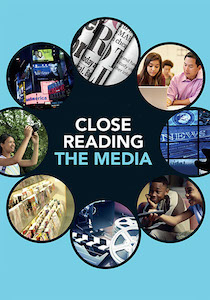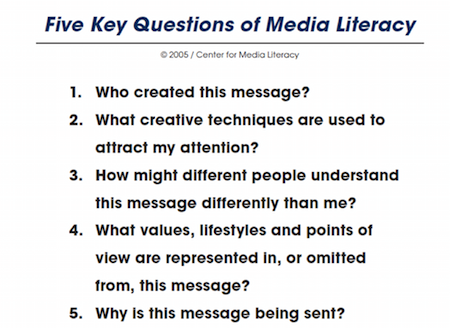When Should We Teach Critical Thinking to Kids?

The theme of this latest “media literacy” column is taken from a bumper sticker I saw recently on the back of a car in front of me (below). You might agree that understanding bumper stickers is also media literacy.
What is “critical thinking”? What is a “deficit”? Do most middle school students know? They may have heard about the “nation’s deficit” in the news. But have they wondered what the implications might be for them?
It’s not clear who produced the bumper sticker or the slogan. It seems to cross political lines. When I talk to people, mostly those in education, they agree that their students simply don’t think critically nor do they ask good questions.
They also seem to be in agreement that the teaching of “critical thinking skills” is lacking in most instruction. (Do you find this to be true also?)
Fake News Is Everywhere
The rise in fake news – fed by those who fall for it and repost such misinformation in social media – has called attention to the lack of critical thinking by many of today’s readers, including our students.
The Foundation for Critical Thinking offers this definition: “Critical thinking is the art of analyzing and evaluating thinking with a view to improving it.” According to FCT, a skillful critical thinker “raises vital questions and problems, formulating them clearly and precisely.” (Source)
As a media educator, I engage in critical thinking and questioning every day. For me it first started when I heard Elizabeth Thoman, the founder of the Center for Media Literacy, say: “Media literacy is not just about asking questions, it’s about asking the RIGHT questions.”
If you haven’t been that involved in teaching or thinking about media literacy, you may be reading Thoman’s key questions for the first time. I think you’ll probably agree that these are the fundamentals your students should consider when they encounter media messages.
These questions can be applied to every kind of media you might use in instruction. That includes photographs, magazine articles, commercials, video/film clips, social media messages, TV programs and much more (yes, even bumper stickers and slogans on t-shirts).
The Center for Media Literacy offers a downloadable “MediaLit Kit” that elaborates on each of Thoman’s questions as well as five parallel media literacy core concepts.
Five Core Concepts
- All media messages are ‘constructed.’
- Media messages are constructed using a creative language with its own rules.
- Different people experience the same media message differently.
- Media have embedded values and points of view.
- Most media messages are organized to gain profit and/or power.
The kit includes an infographic that makes a nice handout or poster for your classroom. It also includes a one-page teacher guide for each of the five question/concept pairs — perfect for quickly developing mini-lessons and facilitating student discussions.
The goal, of course, is to help students begin to develop skills of discernment and to sharpen their own critical thinking tools (in this case, their brains!).
“What’s going on in this picture?”
If you’ve browsed any of my previous media literacy columns and articles here at MiddleWeb, you’ve become accustomed to reading how teaching students to ask the “right” questions is the key to their understanding today’s media, including social media.
One of my own favorite techniques is to demonstrate critical thinking and media literacy instruction by showing a series of slides from the news or popular culture and simply ask: “What’s going on in this picture?”
At a recent arts integration education conference in my home state of South Carolina, I displayed the following photograph and asked the mostly teacher audience my standard question.

As you might guess, some participants responded with a groan, perhaps triggered by confirmation bias.
I explained that the image had been sent to me by a colleague who bemoaned the culture of today’s youth with their noses constantly in their phones. After spending a few moments studying the image through a media literacy lens, I posited to my friend: isn’t it possible that these students are actually engaged, perhaps using their phones for research or to respond to questions?
As it turned out, some quick online research confirmed I was right. The Amsterdam art museum where this snapshot was taken has created a special app with questions for students. The museum even installed benches making it easier for them to respond, after being introduced to the Rembrandt classic by a docent.
My friend (and many others – read this Daily Telegraph story) had “jumped to a conclusion” based solely on the image and personal impressions about “today’s youth.” He had not thought critically about what he was seeing.
And isn’t that exactly what many users of social media do today, students included? They see something and instantly repost or share in social media without any critical thought or investigation? (If I’m wrong there, please let me know.)
So here are my questions for you to consider:
► Why is critical thinking important to you?
► What happens if we don’t teach critical thinking?
► In what ways are you teaching “critical thinking skills” in your classroom?
► In what ways are you assessing the critical thinking skills your students are learning?
► In what ways are you engaging students in asking questions about media messages?
As you answer these questions, if you begin to think that you need to do more, here are some resources that might help.
Resources for Teaching Critical Thinking
Stanford’s Civic Online Reasoning Project
A huge free resource for teachers that’s cross-curricular. “These assessments show students online content—a webpage, a conversation on Facebook, or the comment section of a news article—and ask them to reason about that content. We’ve designed paper tasks as well as tasks that students complete digitally. These tasks are intended for flexible classroom use.”
6 Critical Thinking Assessment Rubrics for Measuring What Matters
Lee Watanabe-Crockett at Global Digital Citizen
How do we know when our learners are thinking critically? Critical thinking assessment can be tricky to perform because it encompasses such broad skills. However, we can begin to assess critical thinking by breaking it down into more basic components, and then determining criteria you can use with your learners.
Three Tools for Teaching Critical Thinking and Problem Solving Skills
Katrina Schwartz at MindShift KQED
Learn how research on “integrative thinking” is helping Canadian educators build critical thinking in students from a young age.
Students Learn from Inquiry, Not Interrogation
Jackie Walsh at MiddleWeb
Building critical thinking skills is closely entwined with quality questioning. Yet students who were surveyed by researchers Jackie Walsh and Beth Sattes most often described their teachers’ questioning technique as “interrogation,” not genuine inquiry. Here’s how to transform your questions and grow critical thinkers.
How to Motivate Students to Take Ownership of Their Learning
Sarah Cooper at The CommonLit Blog
Social studies teacher Sarah Cooper describes how she has used the free CommonLit text resources to grow her middle school students’ discussion and analysis skills. Cooper is also a veteran ELA teacher.
Edutopia’s Critical Thinking Resources
This page at Edutopia curates a rich selection of articles about teaching students to think more critically, “whether via classroom discussions, analysis of written text, higher-order questioning, or other strategies.” See, for example, The Art of Reflection, and Teaching Adolescents How to Evaluate the Quality of Online Information and Turning Your Students into Web Detectives. Also check out Edutopia’s articles tagged Media Literacy.
The Teaching Channel’s Critical Thinking Resources
Another excellent curated resource collection – and this one is video-based. Included are several excellent presentations by former national teacher of the year Sarah Wessling, including her Scaffolds for Critical Thinking (with 4th graders). Also see: Using Critical Thinking to Find Trustworthy Websites (grades 6-8).
What are some of your favorite teaching resources to build critical thinking skills? Please share in the comments.





































Great post, Frank! I absolute LOVE the bumper sticker. Wonder if I could find one online?
I also enjoyed looking through the links you posted. Edutopia and the Teaching Channel always have lots of appropriate resources. I also liked the 6 critical assessment rubrics. I clicked on Grades 6 – 9 (the grades I taught) and some wonderful ideas popped up that also work in STEM critical thinking. (I work with STEM, and critical thinking is a mainstay of that initiative.) The ones I particularly liked (with some STEM-adapted changes in wording) were:
Questioning Abilities—This is all about a learner’s capacity for formulating questions and framing relevant inquiries around a problem or challenge.
Use of Information—Finding information that is useful and relevant to the problem/challenge
Keeping an Open Mind—There are also many possible solutions for most problems and challenges.
Drawing Conclusions—Was the problem solved or the challenge met? What’s next?
Communication & Collaboration. Teamwork, teamwork, teamwork! And be sure to communicate in a manner appropriate to the challenge or problem.
Thanks for posting this interesting topic.
A top resource: https://newslit.org/educators/sift/ And a related issue: https://pvlegs.wordpress.com/2018/06/26/cmon-people-think-about-it/